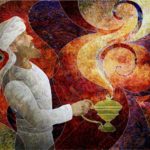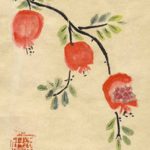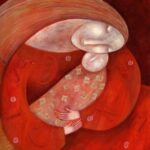Turning Wisdom into Oral Torah
 Shavuot 5784 / 2024 (reprint)
Sarah Yehudit Schneider
If it’s truth then it’s also Torah. [TY RH 3:8]
If someone asserts that the nations have wisdom…believe them. Yet, if someone asserts that the nations have [Oral] Torah, do not believe them.” [LamR 2:13]
Our Written Torah is fixed and final. Its sequence of letters, spacings, stories and commands is sacred and static. A scribal error of even a single letter invalidates the entire scroll. Its authority derives from its constancy. Our Oral Torah is the opposite—it is always changing and expanding. Not a second passes that does not leave it enriched by some new insight discovered in that moment somewhere on the planet. The Oral Torah lives and evolves.
Though the Written Torah came down through the Jewish people at Sinai, says R. Tsadok, its repository of wisdom is available to all. It’s a public document and a global resource. Its stories are universal and everyone’s invited to identify with them.[1]
Yet, says the midrash, it also does tell the story of a real-life people, called the Israelites, who chose G-d at critical points in their odyssey, survived millennia, and who are recognized today as a loosely knit nation called the Jews. Their distinguishing feature, says the midrash, is their power to generate Oral Torah.[2] This is a power of soul likely drawn from the prophesy they shared at Sinai. A searing revelation of Presence engraved the hearts of an entire people with the truth of the universe compressed into a single burst of light. Every Jewish soul (whether embodied or not) experienced that formative event.
Yet what is this mysterious property called Oral Torah. The Midrash connects it to wisdom but does not equate them.[3] Oral Torah is wrapped up in the Jewish experience while wisdom (says Midrash) is free for all.
The Oral Torah has two modes of expression: First is the authoritative chain of rabbinic commentary starting with Moshe and continuing till now. Second is the sum-total of creative insights pressed from the hearts of Jews striving to live with integrity to the truths they absorbed at Sinai.[4]
Oral Torah starts out as a truth or creative insight, but at that point it’s still untethered—a “tower floating in air.”[5] It could be used to excuse this, or justify that…and there’s no way to tell which of these options are true and which are mistaken.
In order to turn that bit of wisdom into Oral Torah, we must identify its source in the Written Torah. “There is no truth except Torah.”[6] If something is true, then it must have a root in the Bible (or also, at this point, in the canonized documents of the Oral Torah such as Mishna, Talmud, Midrash, Zohar, etc.). To find its root, is to link it back to Sinai, and that’s what turns it into Oral Torah.
Shavuot 5784 / 2024 (reprint)
Sarah Yehudit Schneider
If it’s truth then it’s also Torah. [TY RH 3:8]
If someone asserts that the nations have wisdom…believe them. Yet, if someone asserts that the nations have [Oral] Torah, do not believe them.” [LamR 2:13]
Our Written Torah is fixed and final. Its sequence of letters, spacings, stories and commands is sacred and static. A scribal error of even a single letter invalidates the entire scroll. Its authority derives from its constancy. Our Oral Torah is the opposite—it is always changing and expanding. Not a second passes that does not leave it enriched by some new insight discovered in that moment somewhere on the planet. The Oral Torah lives and evolves.
Though the Written Torah came down through the Jewish people at Sinai, says R. Tsadok, its repository of wisdom is available to all. It’s a public document and a global resource. Its stories are universal and everyone’s invited to identify with them.[1]
Yet, says the midrash, it also does tell the story of a real-life people, called the Israelites, who chose G-d at critical points in their odyssey, survived millennia, and who are recognized today as a loosely knit nation called the Jews. Their distinguishing feature, says the midrash, is their power to generate Oral Torah.[2] This is a power of soul likely drawn from the prophesy they shared at Sinai. A searing revelation of Presence engraved the hearts of an entire people with the truth of the universe compressed into a single burst of light. Every Jewish soul (whether embodied or not) experienced that formative event.
Yet what is this mysterious property called Oral Torah. The Midrash connects it to wisdom but does not equate them.[3] Oral Torah is wrapped up in the Jewish experience while wisdom (says Midrash) is free for all.
The Oral Torah has two modes of expression: First is the authoritative chain of rabbinic commentary starting with Moshe and continuing till now. Second is the sum-total of creative insights pressed from the hearts of Jews striving to live with integrity to the truths they absorbed at Sinai.[4]
Oral Torah starts out as a truth or creative insight, but at that point it’s still untethered—a “tower floating in air.”[5] It could be used to excuse this, or justify that…and there’s no way to tell which of these options are true and which are mistaken.
In order to turn that bit of wisdom into Oral Torah, we must identify its source in the Written Torah. “There is no truth except Torah.”[6] If something is true, then it must have a root in the Bible (or also, at this point, in the canonized documents of the Oral Torah such as Mishna, Talmud, Midrash, Zohar, etc.). To find its root, is to link it back to Sinai, and that’s what turns it into Oral Torah.
- When a truth unites with its root it acquires a context, which introduces parameters and a whole network of associations. This greatly enhances the power, richness and usability of that insight.
- When a truth finds its context, it also acquires its paradoxical counter-truth which is the very hallmark of higher wisdom and Oral Torah. The Talmud declares “These and these [which contradict them] are both words of the living G-d.”[7]
An halakhic master [of Oral Torah] is one who can formulate forty-nine perfectly logical and compelling reasons to permit and forty-nine to forbid[8]…and then with a discerning heart, find the ruling best suited to the circumstance at hand.[9]
When a truth gets linked to its Source it acquires infinite depth, a distinguishing mark of Oral Torah. A human brain cannot grasp the fullness of its teaching. In the mystery of that encounter (between finite brain and infinite light) the truth cleaves into two mutually exclusive half-truths that contradict each other and yet, irrationally, are both true. The implications are profound: unless we are grappling with paradox we have not found the root—which means we have not yet turned our wisdom into Oral Torah. The depths and contours of a truth are only visible when viewed in relation to its paradoxical counter-truth.
- When a truth finds its root, it plugs into the burst of consciousness that flashed through the world at Sinai. Now it’s “on the grid” and receives a flow of life juice (called or chadash) which turns it into living Torah, for now it grows, deepens and unfurls its mysteries.
Let us draw upon this resource of soul to navigate through these complex times that leave us no option but to find a balance between change and stability. self-protection and generosity, protest and acceptance, savvy and idealism, zero-tolerance-for-evil and compassion. Hashem, please, on this holy Shavuot, “reveal to us the ‘path of life’”—the most efficient and least painful route to our personal and collective redemption.
חג שמח
——– [1] R. Tsadok HaKohen, אור זרוע, אות ה’. [2] Tanchuma, Vayera 5 [3] The Talmud states: “There’s no wisdom that isn’t Torah;” but it also states, “[If someone asserts that] the nations have wisdom…believe them.” [Yet, if someone asserts that] the nations have [Oral] Torah, do not believe them.” LamR 2:13 [4] R. Tsadok HaKohen, Pri Tsadik (Fruit of the Righteous), Vol 2, Parshat V’Ayra, essay 7; Tsidkat HaTsadik ot 231; Tekanat HaShavin ot 6; Chankha 2 (p. 142); ibid Chodesh Adar, essay 1; Likutei Maamarim p. 80-82; Yisrael Kedoshim p. 152. [5] Chagigah 15b. [6] TY Rosh Hashanah 3:8; Lam R., Petichta 2. [7] TB Eruvin 13b. [8] TY San 21a-b; Sofrim 16:7; Chagiga 3b. [9] Chagiga 3b and Maharsha there. [10] Called הבלא דגרמא )breath of the bones(.



